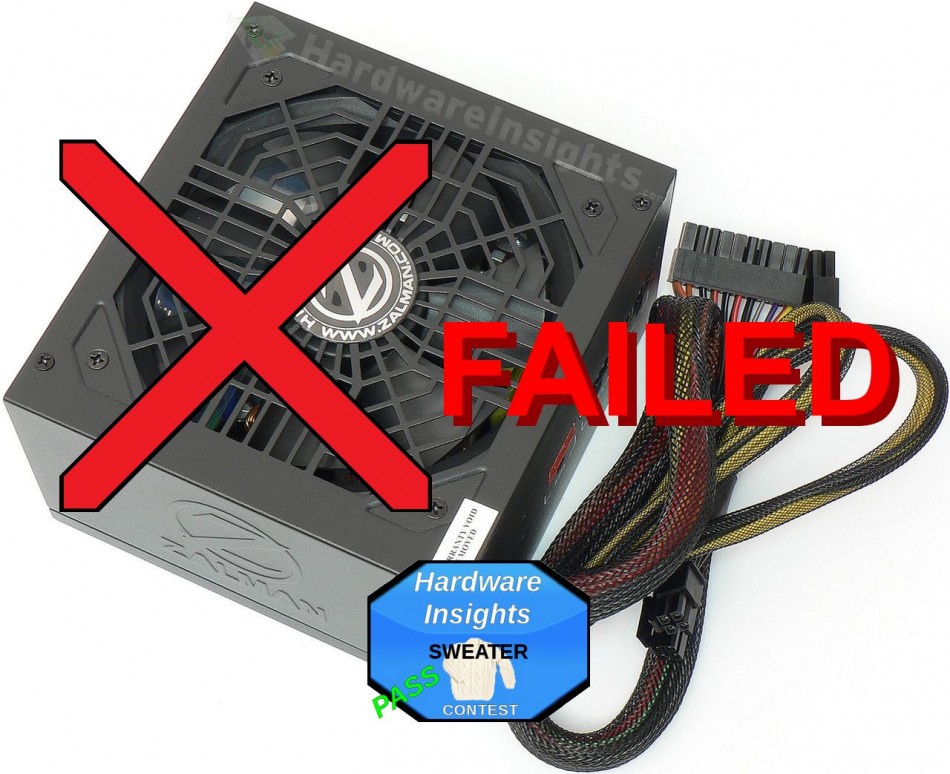Contents
- 1Introduction
- 1.1Packaging and accessories
- 2Connectors & cabling
- 2.1Casing & cooling
- 3Input filtering
- 4Primary side
- 4.1+5 V stand-by rail
- 5Secondary side
- 5.1Build quality
- 6Load testing
- 6.1Loading +5 V SB
- 6.2Voltage hold-up time
- 6.3Combined loading
- 6.4Combined loading ripple
- 6.5Crossloading, overloading
- 6.6Crossloading, overloading ripple
- 6.7Fan speed and temperatures
- 7Conclusion and evaluation
- 7.1Thanks
- 8Addendum - working on the unit
- 8.1Discussion
Conclusion and evaluation
The Zalman ZM500-GVM did not pass the combined and crossload testing in accordance with the ATX specification, so according to my evaluation methodology, it is not deserving of an evaluation. I get the feeling that the HIGH QUALITY sticker on the fan grille is not entirely founded in truth…in fact, some of the ripple values may have very well been amongst the worst I have ever seen. I will say though that I am pleasantly surprised that the voltage regulation stayed in spec even during crossloading with quite a low load on the remaining rails which weren’t crossloaded. And it really does have working over-power protection, which kicked in when we discovered that this unit is capable of providing almost 150 % over its nominal load! It is only a pity that the ripple was already close to 200 mV on the stand-by rail, which is almost four times over the maximum allowed limit…
As for the cooling capabilities, the fan is definitely more silent than those used in Seasonic units, but on the other hand, with this unit running at about 30 °C in ambient temperature, it will always be close to overheating so it does really *need* to have a properly cooled case – if you would even consider it in the first place in the face of its extreme ripple… The unit has quality capacitors which I imagine should help it survive the high internal temperatures, but I guess that because of their tight budget, Sirtec could only afford low-capacity ones which is most likely responsible for such a high ripple current.
If the unit was within spec and cost the same or less than the Cooler Master G550M, it could still be considered somewhat competitive, because although the GM series posesses a superior design, it doesn’t have good capacitors. But under the circumstances, the GVM series seems to be worse in every other aspect, and a couple of good capacitors will not save its reputation when it fails so hard in ripple suppression. We could only hope that the time of these archaic group design platforms will be over in 2016, at least in the higher-end part of the mainstream PSU segment. Because the fact remains: even the worst PSUs with DC-DC converters still almost always perform better than most of the group design platforms.
It is really strange to me that all the Zalman mainstream platforms I have seen so far (LE, GS, and now GVM) are so terribly bad. Bad ripple suppression, voltage regulation (and previously no over-power protection)…and when Zalman does finally get a good high-end platform (like the Enhance-based one in the XG series), they discontinue it so quickly. I really do not understand: people enjoy buying crap instead of quality? Maybe they like the adrenaline rush of not knowing when some of their expensive components will get damaged by their power supply, or when they might catch on fire…
 Pros Pros |
+ working OPP + quality capacitors + modular cabling + longer warranty + OK efficiency (besides low loads/crossload) |
 Cons Cons |
− bad crossload voltage regulation − may run warmer − incredibly bad ripple suppression − low efficiency at crossloads and low loads − short hold-up time (to stay within spec) |
 Be aware of… Be aware of… |
/?\ buying this unit |
Thanks
I thank the Zalman company for providing the Zalman ZM500-GVM unit.


